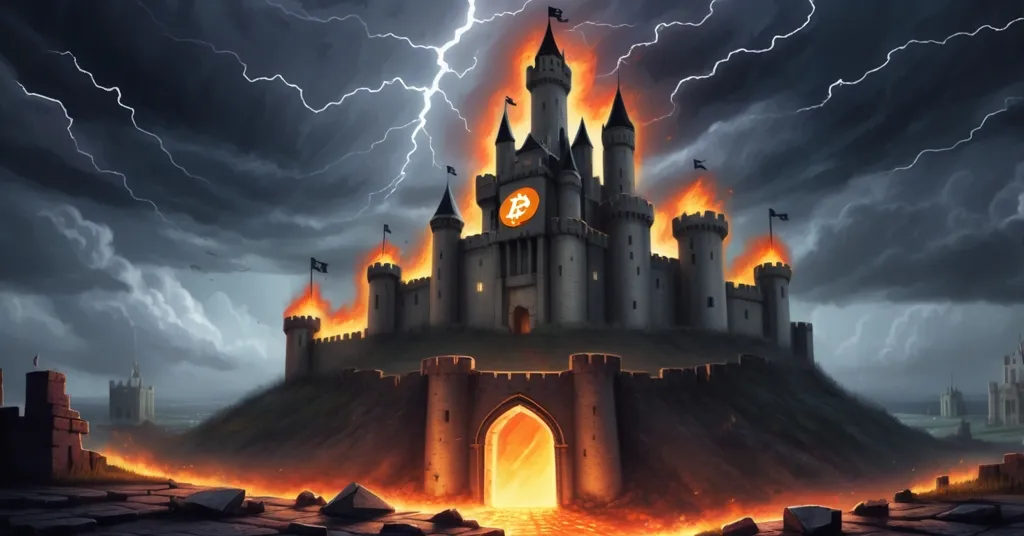Caitlin Long Slams Ripple: XRP Deemed Centralized and Unfit for Institutional Finance

Ripple Scorched by Caitlin Long: XRP Deemed Untrustworthy and Doomed in Institutional Finance
Caitlin Long, the outspoken CEO of Custodia Bank, has unleashed a fiery critique of Ripple and its native token XRP, calling into question their relevance and viability in the world of institutional finance. During a recent appearance on the Gold Goats ‘n Guns podcast, Long didn’t mince words, branding Ripple as a failed experiment due to its centralized structure, questionable tokenomics, and persistent distrust from banks. Her scathing remarks have reignited debates within the crypto community about centralization, trust, and the future of blockchain in traditional finance.
- Centralized Flaws: Long criticizes Ripple’s centralized architecture as a fundamental weakness compared to Bitcoin and Ethereum.
- Tokenomics Trouble: A massive pre-mine and upfront fundraising by founders fuel distrust and fears of market manipulation.
- Institutional Rejection: Banks remain wary, and Ripple’s pivot to a stablecoin is seen as an admission of failure to gain traction.
Centralization: Ripple’s Achilles’ Heel
At the heart of Long’s criticism lies Ripple’s centralized network design, a stark contrast to the decentralized ethos that defines Bitcoin and Ethereum. Unlike Bitcoin, which relies on a global network of independent miners to validate transactions through proof-of-work, or Ethereum, which uses proof-of-stake with a broad base of validators, Ripple operates on the XRP Ledger with a pre-selected group of validators. Think of it as a boardroom of handpicked decision-makers versus a chaotic, open town hall where anyone can participate. Long argues this setup is a dealbreaker for institutions that prioritize security and resilience over mere speed.
“The banks have always been suspicious of it. It is a centralized network and the tokenomics are backwards,”
she declared, highlighting how this centralization undermines trust in a sector where trust is everything.
For those new to the space, centralization means a system is controlled by a limited group of entities, making it more vulnerable to manipulation or failure if those entities act maliciously or get compromised. Decentralization, as seen in Bitcoin, spreads control across thousands of nodes worldwide, ensuring no single point of failure. Ripple’s approach, while efficient for processing transactions quickly, raises red flags for banks that fear a lack of transparency or potential overreach by Ripple Labs itself. Long’s point is brutal but clear: if you’re not decentralized, you’re not playing the long game in crypto.
Tokenomics Disaster: The Pre-Mine Problem
Beyond structure, Long takes aim at Ripple’s tokenomics and massive pre-mine controversy. When Ripple launched, a staggering 100 billion XRP tokens were created, with a huge portion allocated to founders and the company before any public release. This is known as a pre-mine, a practice often criticized in crypto circles because it concentrates wealth and power in the hands of a few, raising concerns about fairness and potential market dumps. Long doesn’t hold back on the implications.
“The people who extracted money up front are never going to be trusted because everybody is going to look and think that anything they do is an exit scam to try to dump on retail,”
she warned, suggesting that banks and investors alike fear Ripple’s early holders could flood the market, crashing XRP’s value and leaving everyday investors burned.
At the time of her comments, XRP was trading at $2.94, though some recent market chatter suggests it’s nudged above $3, driven more by speculative fervor than solid fundamentals. Compare this to Bitcoin or Ethereum, where token distribution evolved organically with minimal upfront fundraising, building trust through community-driven growth. Long sees Ripple’s pre-mine as a stain that no amount of marketing can wash out, a stark reminder of why trust in crypto isn’t just coded into the blockchain—it’s coded into perception.
Mission Failure: No SWIFT Replacement in Sight
Ripple’s original pitch was ambitious: replace SWIFT, the decades-old global interbank messaging system that handles trillions in cross-border payments, with a faster, cheaper alternative using XRP as a bridge currency. On paper, it sounded revolutionary. In practice, Long says, it’s been a flop.
“It’s not going to take over. If it were going to take over, it would have taken over a long time ago,”
she snapped, dismissing Ripple’s grand vision.
“The base layer network is not going to become the base layer of replacing SWIFT,”
she added, driving the nail deeper. Despite years of high-profile partnerships with financial institutions like Santander and MoneyGram, Ripple hasn’t become the backbone of interbank settlements it promised to be.
Why the stall? Beyond centralization, banks hesitate due to regulatory uncertainty and the lingering distrust from that pre-mine fiasco. While Ripple boasts transaction speeds of seconds compared to SWIFT’s days, speed alone doesn’t seal the deal when institutions weigh legal risks and long-term reliability. Long contrasts this with Bitcoin and Ethereum, which, despite their own scaling challenges, have earned credibility through decentralized models with no shady upfront cash grabs. Her verdict is harsh: Ripple’s been at this game longer than most, yet the scoreboard still reads zero.
“Ripple’s been at this longer than almost anybody else and they haven’t made a lot of progress. It’s really that simple,”
she concluded.
Stablecoin Pivot: Surrender or Strategy?
Adding salt to the wound, Long interprets Ripple’s recent moves as a white flag. The company announced plans to launch a regulated stablecoin—a cryptocurrency pegged to a stable asset like the US dollar to avoid volatility—and is reportedly pursuing a US bank charter. For Long, this isn’t a bold reinvention but a retreat.
“That’s kind of, in some ways, an admission that the base layer blockchain didn’t get the adoption they were looking for,”
she argued. In her view, Ripple is conceding that XRP and its ledger couldn’t cut it as the foundation for institutional finance, pivoting to stablecoins as a desperate bid for relevance.
But let’s play devil’s advocate for a moment. Could this pivot be a sign of maturity rather than defeat? Stablecoins are gaining traction in traditional finance for their predictability, and aligning with regulatory frameworks via a bank charter might be a pragmatic way to bridge crypto and legacy systems. Ripple’s history of working with banks suggests they’re not abandoning their roots but adapting to a hostile environment. Still, Long’s scorching critique of XRP’s viability holds weight—if the core blockchain couldn’t deliver, why trust the sequel? Her Bitcoin-leaning lens sees this as a step away from the disruptive spirit of crypto, not toward it.
Regulatory Quagmire: Ripple’s Endless Battle
Ripple’s struggles aren’t just technical or economic; they’re legal. Since 2020, the company has been tangled in a high-profile lawsuit with the US Securities and Exchange Commission (SEC), accused of conducting an unregistered securities offering with XRP. This ongoing SEC legal battle has drained resources, scared off potential partners, and tarnished Ripple’s image among risk-averse institutions. Long points to this as a crippling setback, compounded by a broader anti-crypto stance under the Biden administration that’s hammering the industry with regulatory scrutiny. Her own Custodia Bank has felt the sting, denied a Federal Reserve master account, so she’s not speaking from a place of detached privilege.
For context, the SEC lawsuit hinges on whether XRP should be classified as a security—akin to a stock—subject to strict regulations, or as a currency free from such oversight. A partial legal win in 2023 offered Ripple some breathing room, ruling that XRP sales on exchanges weren’t securities, but the case remains unresolved. Until clarity emerges, banks are likely to keep their distance, validating Long’s assertion that Ripple’s baggage is a dealbreaker in institutional circles.
Tokenization Future: Ethereum, Not Ripple
Looking to the horizon, Long makes a bold call on tokenization—the process of digitizing real-world assets like US Treasuries on a blockchain, poised to revolutionize finance with a projected $2 trillion market by 2030, per McKinsey. With benefits like 24/7 settlement and operational efficiency, tokenization is the next battleground for blockchain dominance. Long doesn’t see Ripple anywhere near the podium.
“They’re not going to use Ripple. They’re going to use Ethereum. They may use Bitcoin, but the Bitcoin layer twos are not mature enough for something like that,”
she predicted. Ethereum’s robust smart contract capabilities and widespread adoption (think BlackRock’s tokenized funds) make it the frontrunner for the US Treasury’s tokenization efforts compared to Ripple, while Bitcoin’s layer-two solutions—scaling tools like the Lightning Network built atop the base chain for faster, cheaper transactions—aren’t yet ready for prime time.
Ripple’s exclusion from this future isn’t just a slight; it’s a statement on its irrelevance in Long’s eyes. Ethereum’s technical maturity and decentralized credibility outshine Ripple’s hybrid model, and even Bitcoin, despite scaling hiccups, carries a trust factor Ripple can’t match. If tokenization is the future of finance, Long bets Ripple’s stuck in the past.
Community Clapback: Bias or Truth?
The XRP community isn’t taking this roast lying down. Prominent voices like Crypto Eri have lashed out, calling Long’s critique tribalistic and a letdown for the broader blockchain space.
“The entire blockchain community should be deeply disappointed,”
Eri stated, implying Long’s comments fuel division rather than constructive debate. Others, like Ashley Prosper, suggest Long’s harshness might stem from frustration over Custodia Bank’s own regulatory roadblocks, especially as Ripple edges toward potential breakthroughs like a bank charter. Market optimists, such as the Digital Asset Investor, argue Ripple remains on track, with some analysts throwing out XRP price predictions from $3.50 to a delusional $15 by 2025.
Let’s cut through the noise. Those sky-high forecasts are more fantasy than fact, often peddled by shills riding waves of hopium. We’re not here to peddle baseless hype—our mission is to keep it real. That said, the community’s pushback raises a fair question: is Long’s Bitcoin-friendly bias clouding her judgment, or is she just calling a spade a spade? Her critique of Ripple’s centralization, as echoed in community discussions, aligns with a maximalist view that decentralization is non-negotiable, but Ripple’s niche in cross-border payments—evidenced by real-world partnerships—suggests there might still be a sliver of value in their approach, even if it’s not the pure crypto ideal.
What’s Next for Ripple?
As the dust settles on Long’s verbal smackdown, Ripple stands at a crossroads. A favorable SEC ruling could spark renewed interest, with some even speculating about a spot ETF (exchange-traded fund) for XRP, mirroring Bitcoin’s recent mainstream strides. Their stablecoin pivot might win over cautious banks looking for less volatile blockchain solutions. Yet, Long’s warnings about centralization and why banks distrust XRP linger like a bad aftertaste. If Ripple can’t shed its baggage, it risks being sidelined as Ethereum and Bitcoin’s layer-two innovations dominate the tokenization race.
From a Bitcoin-first perspective, Long’s words resonate with the ethos of freedom and decentralization that crypto was built on—trust earned through code, not corporate handshakes. But let’s not write off Ripple entirely. Their struggles reflect a broader tension in crypto: balancing disruptive innovation with the realities of regulation and institutional adoption. Whether Ripple reinvents itself or fades into obscurity, one thing’s certain—this space doesn’t forgive stagnation for long.
Key Takeaways and Questions on Ripple, XRP, and Caitlin Long’s Critique
- What are Caitlin Long’s main criticisms of Ripple and XRP?
Long slams Ripple for its centralized architecture, flawed tokenomics from a massive pre-mine, and lack of trust from banks, arguing it’s unlikely to replace systems like SWIFT as a base layer for interbank settlements. - How does Long compare Ripple to Bitcoin and Ethereum?
She praises Bitcoin and Ethereum for their decentralized models and minimal upfront fundraising, positioning them as more trustworthy for institutional adoption compared to Ripple’s centralized structure and pre-mine distrust. - Why does Long see Ripple’s stablecoin pivot as significant?
Long views it as an admission of failure, suggesting Ripple’s base layer blockchain couldn’t achieve the anticipated traction in institutional finance, prompting a shift to stablecoins as a fallback. - What is Long’s prediction for the US Treasury’s tokenization choice?
She forecasts the US Treasury will opt for Ethereum over Ripple due to its technical maturity and smart contract capabilities, while Bitcoin’s layer-two solutions remain too immature for such applications. - How has the XRP community responded to Long’s harsh critique?
Figures like Crypto Eri and Ashley Prosper have pushed back, labeling her comments tribalistic and hinting they may reflect personal frustrations with Custodia Bank’s regulatory challenges. - What regulatory obstacles does Ripple face, according to Long?
Long highlights Ripple’s ongoing SEC lawsuit over an alleged unregistered securities offering as a major hurdle, worsened by broader hostility toward crypto under the Biden administration.



